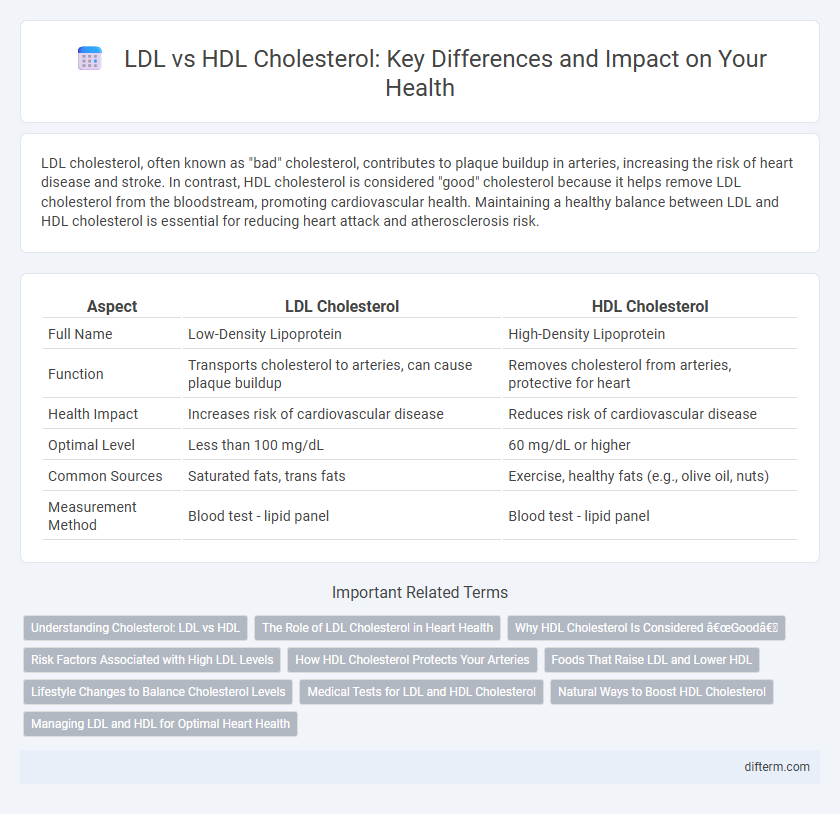LDL cholesterol, often known as "bad" cholesterol, contributes to plaque buildup in arteries, increasing the risk of heart disease and stroke. In contrast, HDL cholesterol is considered "good" cholesterol because it helps remove LDL cholesterol from the bloodstream, promoting cardiovascular health. Maintaining a healthy balance between LDL and HDL cholesterol is essential for reducing heart attack and atherosclerosis risk.
Table of Comparison
| Aspect | LDL Cholesterol | HDL Cholesterol |
|---|---|---|
| Full Name | Low-Density Lipoprotein | High-Density Lipoprotein |
| Function | Transports cholesterol to arteries, can cause plaque buildup | Removes cholesterol from arteries, protective for heart |
| Health Impact | Increases risk of cardiovascular disease | Reduces risk of cardiovascular disease |
| Optimal Level | Less than 100 mg/dL | 60 mg/dL or higher |
| Common Sources | Saturated fats, trans fats | Exercise, healthy fats (e.g., olive oil, nuts) |
| Measurement Method | Blood test - lipid panel | Blood test - lipid panel |
Understanding Cholesterol: LDL vs HDL
LDL cholesterol, often referred to as "bad cholesterol," contributes to plaque buildup in arteries, increasing the risk of heart disease and stroke. In contrast, HDL cholesterol, known as "good cholesterol," helps remove excess cholesterol from the bloodstream and transports it to the liver for excretion. Maintaining a healthy balance between LDL and HDL cholesterol levels is crucial for cardiovascular health and reducing the likelihood of atherosclerosis.
The Role of LDL Cholesterol in Heart Health
LDL cholesterol, often referred to as "bad" cholesterol, plays a critical role in the development of atherosclerosis by depositing fatty plaques in the arterial walls, which can lead to heart disease and stroke. Elevated LDL levels are strongly associated with an increased risk of coronary artery disease due to impaired blood flow and potential arterial blockages. Managing LDL cholesterol through diet, exercise, and medications like statins is essential for reducing cardiovascular risk and promoting overall heart health.
Why HDL Cholesterol Is Considered “Good”
HDL cholesterol is considered "good" because it helps remove excess cholesterol from the bloodstream, transporting it to the liver for excretion or recycling. High levels of HDL cholesterol reduce the risk of plaque buildup in arteries, preventing atherosclerosis and cardiovascular diseases. Unlike LDL cholesterol, which deposits cholesterol in artery walls, HDL cholesterol promotes cardiovascular health by maintaining arterial flexibility and function.
Risk Factors Associated with High LDL Levels
High LDL cholesterol significantly increases the risk of atherosclerosis, leading to coronary artery disease, stroke, and peripheral artery disease. Elevated LDL levels contribute to plaque buildup in arteries, causing reduced blood flow and potential heart attacks. Risk factors linked to high LDL include poor diet rich in saturated fats, obesity, sedentary lifestyle, smoking, and genetic predispositions like familial hypercholesterolemia.
How HDL Cholesterol Protects Your Arteries
HDL cholesterol, known as "good cholesterol," helps protect your arteries by removing excess LDL cholesterol from the bloodstream and transporting it to the liver for excretion. This process reduces plaque buildup in arterial walls, lowering the risk of atherosclerosis and cardiovascular disease. Higher HDL levels correlate with improved arterial health and decreased incidence of heart attacks and strokes.
Foods That Raise LDL and Lower HDL
Foods high in trans fats, such as fried fast foods, baked goods with hydrogenated oils, and processed snacks, significantly raise LDL cholesterol levels, increasing cardiovascular risk. Diets rich in refined carbohydrates and sugary beverages can lower HDL cholesterol, diminishing the body's ability to remove arterial plaque. Saturated fats from red meat and full-fat dairy products also contribute to higher LDL while failing to boost protective HDL cholesterol.
Lifestyle Changes to Balance Cholesterol Levels
Balancing LDL and HDL cholesterol levels can be effectively achieved through targeted lifestyle changes such as adopting a diet rich in fiber, healthy fats, and plant sterols, which help lower LDL cholesterol. Regular physical activity, including aerobic exercises like walking or cycling, increases HDL cholesterol and supports overall cardiovascular health. Avoiding smoking and limiting alcohol intake also play critical roles in maintaining a healthy cholesterol balance and reducing the risk of heart disease.
Medical Tests for LDL and HDL Cholesterol
Medical tests for LDL and HDL cholesterol primarily involve a lipid panel or lipid profile, which measures the levels of these lipoproteins in the bloodstream. LDL cholesterol, known as "bad" cholesterol, is assessed to evaluate the risk of atherosclerosis and cardiovascular disease, while HDL cholesterol, or "good" cholesterol, is measured for its protective effects on heart health. Accurate quantification of LDL and HDL levels guides clinicians in tailoring interventions and monitoring treatment efficacy to reduce the risk of coronary artery disease.
Natural Ways to Boost HDL Cholesterol
Increasing HDL cholesterol, known as "good" cholesterol, can be achieved through natural methods such as regular aerobic exercise, consuming healthy fats like omega-3 fatty acids found in fish and flaxseeds, and maintaining a balanced diet rich in fruits, vegetables, and whole grains. Avoiding trans fats and smoking cessation also play crucial roles in elevating HDL levels. Incorporating these lifestyle changes enhances cardiovascular health by promoting the removal of LDL cholesterol, which contributes to plaque buildup and heart disease risk.
Managing LDL and HDL for Optimal Heart Health
Managing LDL cholesterol involves reducing intake of saturated fats and trans fats, increasing soluble fiber intake, and incorporating regular physical activity to lower plaque buildup in arteries. Elevating HDL cholesterol can be achieved through aerobic exercises, consuming healthy fats such as omega-3 fatty acids, and avoiding smoking, as HDL helps remove excess cholesterol from blood vessels. Maintaining an optimal balance between low LDL and high HDL cholesterol is crucial for preventing cardiovascular diseases and promoting overall heart health.
LDL Cholesterol vs HDL Cholesterol Infographic

 difterm.com
difterm.com